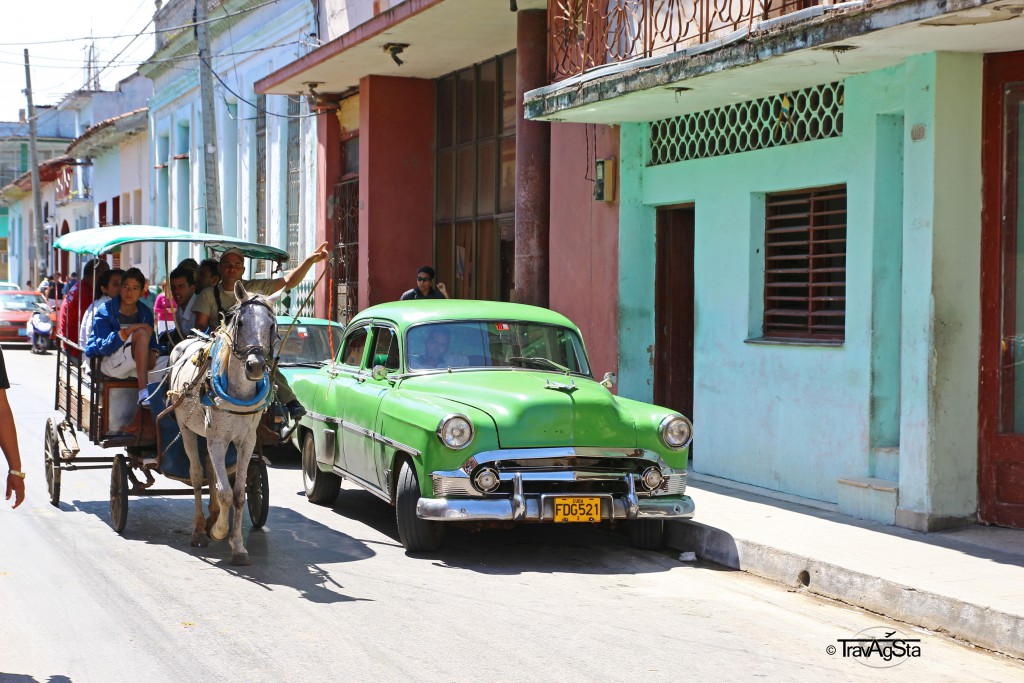We booked this trip at a state-owned tourist travel agency. Taxi driver, guide and lunch for 70 CUC. We told at the agency, where we wanted to head and they organized it. It wasn’t very cheap, but the flexibility, the comfort and what we were able to see were worth the price.
We had a driver and a guide. They told us anything, they thought tourist might want to hear.
But we were mostly interested in their daily lives. Their system, you know! Not that we were rudely asking them about everything or squeezed the information out of them. They were not sparing of words. The opposite was the case.
Political subjects were by-passed, they just changed the topic. But they told us about their daily lives:
Our driver bought his mother’s heart pills in Santa Clara as there were none in Trinidad at that time. A friend gave him the hint and also told him in which pharmacy. He blustered about the mismanagement in the country and that you always need to know someone. At that time, he had to buy medicine in Santa Clara and water in Cienfuegos.
Our guide told us, that she’s already a grandma. Her son and his wife are “forced” to live in Venezuela. Because of an Cuban-Venezuelan deal, a lot of Cuban doctors were sent to Venezuela.
In return, they get cheap oil and foreign exchange. As her son and his wife are living there, she has to take care of her grandchildren. They don’t see their children very often, as it is too expensive. Retirement? Doesn’t exist for her.
So what did we see during our trip?
Sierra de Escambray
Our way to Topes de Collantes led us through the mountains south of Santa Clara. Our driver brought us as the far as the roads let us. From here, we could enjoy a perfect view from the top of Sierra de Escambray. It was astonishingly fresh up there.
Topes de Collantes
This national park is located in the heart of the Sierra the Escambray. If you want, you can also walk up there and through the mountain forests. Of course, this takes more time. You can find waterfalls here, though not in March at the peak of dry season.
Coffee plantation with a little museum
Before heading to Santa Clara, we made a stop at a coffee plantation. There was also a little museum, showing how coffee was made back in the old days. There were tools and machines. It was nice, but not spectacular. We didn’t spend much time there.
Santa Clara
We never saw such a “Che”-cult anywhere else like in Santa Clara. We got our first foretaste when entering the city.
Why Santa Clara? 1958 Che and his 150 men defeated the troops of the old colonial masters. The game-changing battle between the revolutionaries and the Batista-Regime took place in this city. Decisive was the takeover of the armoured train (Tren Blindado), sent by Batista for strengthening his troops.
Well worth seeing, especially because of the history, are the Che-Guevara memorials. Most important is the Monumento y Memorial Ernesto Che Guevara. This huge monument was built in 1988. In the middle of the 17500m² square stands a bronze-statue of Che, 7 meters tall.
On the left side is a wall area on which you can see Che’s long march from the Sierra Nevada and the escalade of the Batista train. Furthermore there are quotes of the “Guerillero Heróico” and his goodbye letter to Fidel Castro engraved in stones.
There is a museum underneath the square.
On the other side, there are Che’s and his combatants graves, brought to Cuba from Bolivia in 1997. They were found in a mass grave.
What you should also see, is the Monumento Nacional del Tren Blindado.
An exhibition in train wagons shows weapons and photos of the events.
North of the party headquarters: El Estatua Che y Niño. The boy, Che carries on his arm, symbolizes the next generation.
At the end, we went to Parque Vidal. It’s named after Leoncido Vidal, a leader during the war of independence.
Cienfuegos
After a very rich cuban meal, we continued our trip to Cienfuegos. Just like Trinidad, this city became rich with sugar cane. The port of Cienfuegos is one of the biggest sugar cane ports in the world.
Cienfuegos is also described as the pearl of the south. You can see its wealth by all the art and the historic buildings, designed in the style of neoclassic, art-nouveau and art-deco. Nevertheless it’s less visited than other cities – no comparison to Havana or Trinidad.
Things worth seeing: Parque Martí. The only triumphal arch was built here in 1902, due to the country’s independence.
In the middle, you can find a statue of Jose Martí surrounded by magnificent buildings in French style, like the Teatro Tómas Terry. There is also the former city hall Antiguo Ayuntamiento, in which the provincial government is based today. There is no entrance for tourists.
The glory avenue (Prado) leads to the Malecón. Until the mid of the 20th century, blacks and whites had to stay at their side of the street. Blacks on the left, Whites on the right.
Our highlight was the beautiful Cementario La Reina, Cuba’s oldest graveyard. Besides the fallen soldiers during the independence war, there are also the graves of some of Batista’s kin.
It became famous because of the sculpture of La Bella Durmiente.
According to the legend, “the sleeping beauty” committed suicide, after becoming pregnant from an affair with an Italian.
In her right hand, she holds an opium plant. In her left hand, she holds a snake, symbolizing the poison.
One of the most beautiful graveyards, we’ve seen so far.
Afterwards, the one in Havana turned out to be even more beautiful!
